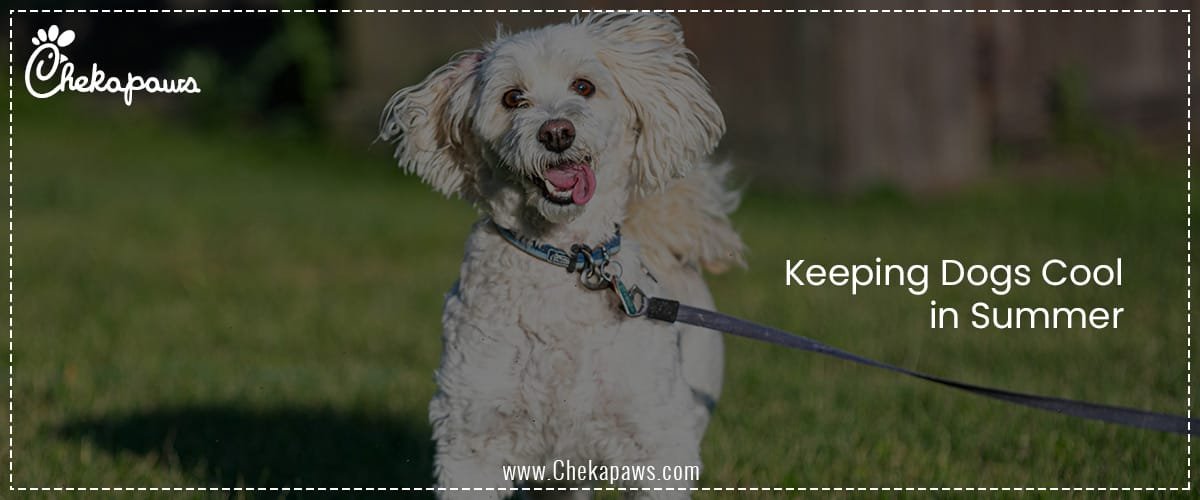As a pet parent, I am aware that summer temperatures can rise and present special difficulties for our beloved companions. Dogs can quickly become overheated since they don’t sweat as much as humans do. During hot months, dogs are at serious risk for heatstroke, dehydration, and burnt paw pads. Whether you’re at home, on a walk, or on vacation, this in-depth guide will teach you everything you need to know to keep your dog cool, healthy, and content throughout the summer.
Table of Contents
Understanding the Risks of Summer Heat for Dogs
How Dogs Stay Cool
- Dogs mainly use limited skin radiation, sweating through their paw pads, and panting to control their body temperature.
- Dogs cannot rely on sweating their entire bodies to stay cool, unlike humans.
Common Summertime Risks
- Heatstroke: May happen rapidly. Lethargy, vomiting, collapse, and drooling are some of the symptoms.
- Dehydration: Usually ignored until it gets really bad.
- Dogs with thin coats or light skin are especially vulnerable to sunburn.
- Burned Paw Pads: Sand and pavement can get as hot as 140°F (60°C).
Most Dangerous Breeds
- Breeds that are brachycephalic, such as pugs and bulldogs
- Older dogs
- Pups
- Dogs whose fur are thick or dark
At-Home Cooling Strategies
Ideal Indoor Conditions
- Make use of air conditioning and fans.
- During peak hours, use blackout curtains or blinds to block sunlight.
- Cooling mats should be placed in locations with shade.
Hydration Advice and Frozen Treats
- Make your own frozen dog treats: In ice cube trays, blend the peanut butter, banana, and yoghurt.
- Throughout the house, keep many bowls of water.
- To promote drinking, utilise pet fountains or add ice cubes.
Products for Cooling
- Gel or water-based cooling mats or vests.
- fans that don’t overheat and are safe for pets.
- chilled scarves or bandanas.
Tips for Summer Grooming
- Frequent brushing will help get rid of extra fuzz.
- Fur helps protect against UV rays, so don’t shave unless a veterinarian advises you to.
- Paw fur should be trimmed to prevent heat retention.
Safe Outdoor Fun
The Best Times to Take a Walk
- Late evening (after 7 PM) and early morning (before 9 AM).
- Stay out of the sun between 10 AM and 4 PM.
Inspect the pavement
Put your hand or bare foot on the ground and follow the 7-second rule. Your dog will find it too hot if it’s too hot for you.
Games in the Water
- Sprinklers and kiddie pools: Splash time under supervision might help reduce body heat.
- Hose play: To prevent pain, use a low water pressure.
Visits to Parks
- Look for wooded parks or shaded paths.
- Carry a portable water dish and take frequent rests.
Hydration Is Key
Is There Enough Water?
Every day, dogs require roughly one ounce of water for every pound of body weight; this amount increases in hot weather or after physical exertion.
Signs of dehydration.
- Laziness
- Eyes that are sunken
- Skin elasticity loss
- Dry Gums
Improving the Attractiveness of Water
- Fill water bowls with a little low-sodium chicken broth.
- Make use of a pet fountain that circulates.
- Serve meals high in water, such as cucumbers or seedless watermelon.
Summer Nutrition
Lighter Meals
- Lessen the amount of energy required to digest large meals.
- Think about eating more often and in smaller portions.
Foods That Hydrate
- Watermelon, blueberries, and cantaloupe are safe summertime fruits.
- Cucumbers and carrots provide moisture and crunch.
Avoidable Treats
- No salty or chocolatey treats.
- Anything greasy that could lead to pancreatitis in the heat should be avoided.
Travel Tips During Summer
Vehicle Safety
- Never, even for a little while, leave your dog in a parked automobile.
- Make use of cooling seat covers and sunshades.
- Bring water, a portable fan, and a cooling vest.
Road trips and vacations
- Arrange air-conditioned accommodations that are pet-friendly.
- Mark out rest areas that are dog-friendly.
- Bring a pet travel package that includes poop bags, water, a cooling pad, and first aid supplies.
Days at the Beach
- Select beaches with shaded areas that are dog-friendly.
- Rinse after swimming in salt water.
- Make sure there is always access to water and shade.
Monitoring for Heat-Related Illnesses
How to Identify Heatstroke
- Temperature of the body above 103°F (39.4°C)
- Drooling and panting quickly
- Getting lost or passing out
Overheating First Aid
- Take your dog right away to a cool, shaded spot.
- Serve water, but not ice-cold.
- Wet cloths on the tummy and paws, but not all at once.
- See a veterinarian right away.
When to Contact the Veterinary
Take immediate action if your dog exhibits symptoms of disorientation, profuse drooling, vomiting, or unconsciousness.
Indoor Activities for Hot Days
Puzzle Toys
- Energy can be burned indoors with mental stimulation.
- For cold play, use frozen Kong toys.
Instructional Activities
- Teach new tricks or practise commands.
- keeps your dog’s mind active.
Obstacle Course Indoors
- Make use of boxes, tunnels, or cushions.
- Allow them to run and leap in a cool, safe area.
Summer Essentials for Every Dog Owner
Essential Equipment
- Collapsible water bowl
- Sunscreen that is safe for dogs
- Cooling vest or bandana
- Hot pavement dog booties
- Reflective clothing for strolls in the evening
Checklist for Summer Safety
- Water on-the-go.
- Paws safe.
- Take a stroll while it’s cooler.
- Observed for indications of heat.
- Available shaded areas.
DIY Projects for Summer Comfort
Place zip lock bags under blankets after filling them with water and freezing them.
Make use of towel-wrapped, gel-filled cold packs.
Shade Shelters
- In your backyard, construct a do-it-yourself canopy using reflective fabric.
- For temporary shade, use pop-up tents or umbrellas.
Mats of Frozen Lick
- On a silicone mat, spread baby food, yoghurt, or pumpkin.
- For a refreshing treat, freeze and serve.
Myths vs. Facts
Myth
- Dogs sweat to cool down itself.
- All fur should be shaved.
- Dogs don’t get sunburn
- For heatstroke, ice water is beneficial.
Facts
- They use paw pads and panting to stay cool.
- can result in skin heating from UV exposure.
- Many dogs, particularly those with short hair, get sunburnt.
- Cool water, not cold water, is safer because it can shock their system.
Conclusion
Keeping your dog cool throughout the summer is important for their health as well as their comfort. You can let your dog enjoy the season without endangering their health if you are mindful, prepared, and employ a few clever tactics.
Be an advocate for your dog. Always have a plan for the heat, reassess your regular routines, and make staying hydrated enjoyable. If you take proper care of your pet, summer may be a season of happiness and connection rather than danger.







